Welcome back to The Neuroscience Meets Social and Emotional Learning Podcast where we bridge the gap between theory and practice, with strategies, tools and ideas we can all use immediately, applied to the most current brain research to heighten productivity in our schools, sports environments and modern workplaces. I’m Andrea Samadi and launched this podcast to share how important an understanding of our brain is for our everyday life and results. Like you, I’m interested in learning and applying the research, to our everyday life.
For this week’s Brain Fact Friday, I want to look at the Japanese term “Kaizen” that means “change for the better” or “continuous improvement” as we enter the last quarter of 2022. If you follow this podcast, we launched our year with a 6 PART study of the bestselling book, Think and Grow Rich, that ended with EPISODE #196[i] on “The Neuroscience Behind the 15 Success Principles of Napoleon Hill’s Classic Book, Think and Grow Rich” ensuring that we all make 2022 our best year ever with this detailed study. I’ve been studying this book chapter by chapter, at the start of every year, since 2019, which doesn’t seem like a long time, but if you go back to this book study, you’ll see that it’s quite intensive. The notes I share came from 2 of my mentors who have studied this book for their entire life. It took me to the beginning of February to properly cover these 15 success principles, with enough content in this series to continue to study this book, every year, for the rest of OUR lives, and we will still pick up something new. We will cover this on today’s episode, but success with these principles doesn’t happen immediately. But it will happen, with time, which is why I think it’s crucial to revisit this book (and success principles) throughout the year, to be sure the concepts are being applied, not just in January, when we are starting our year, but every month of the year, right through to end of Q4. There are 6 STEPS in this book, that I’ve written on my wall, that when read aloud every day, causes an increase in the amplitude of our thinking, until eventually, our goals become so engrained in our mind, that they become on autosuggestion in our thoughts throughout our day. Napoleon Hill intended this book to be studied over and over again, not just once, but multiple times, for results to occur.
We opened this 6 PART series at the start of the year with a quote from Undercover Billionaire Grant Cardone, who said, “In order to get to the next level of whatever we’re doing, we must think and act in a wildly different way than we previously have been” and I know I’ve repeated this quote often throughout the year, (on various episodes) but I’m doing it on purpose, since making any sort of change takes time. It doesn’t happen overnight, or immediately, or how our brain wants to see things unravel, because success is nonlinear[ii]. I heard this concept the other day, and it made me stop and think for a minute. When you hear “success in nonlinear” what do you think about? I thought about that image of the person riding their bike with their plan in mind, towards their goal, but in reality, there are many obstacles along the way.
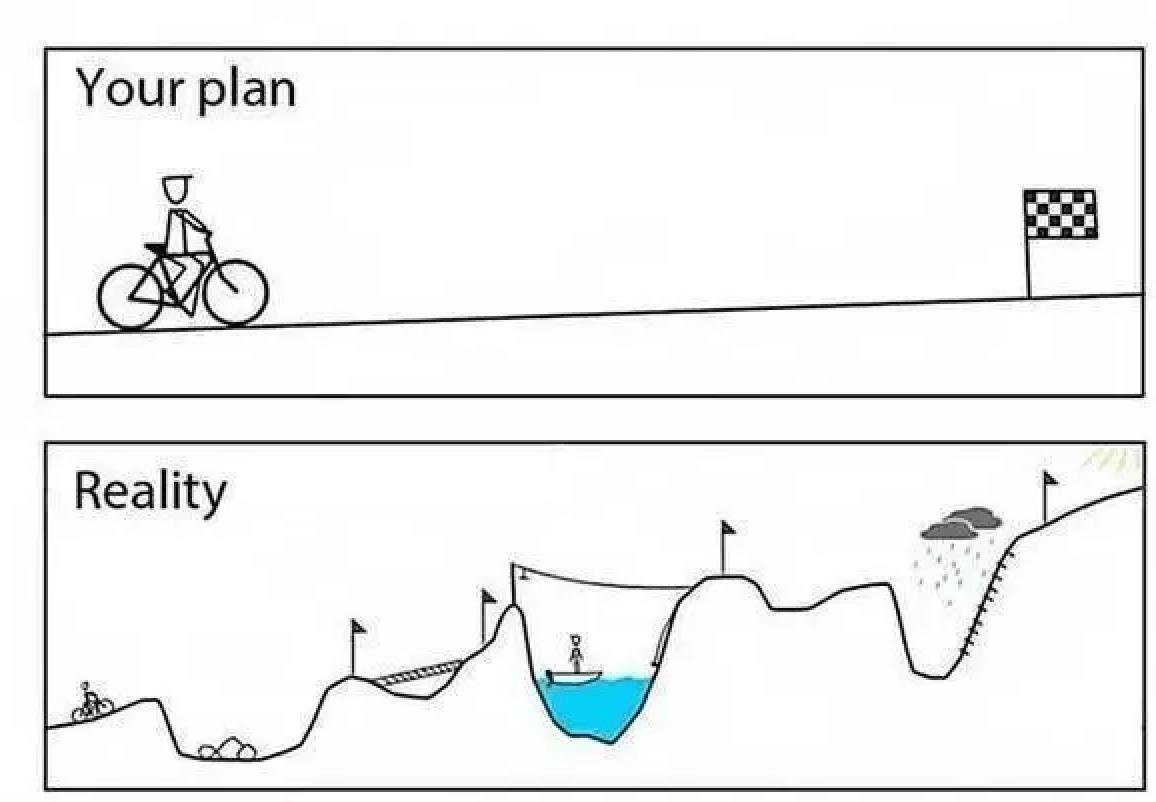
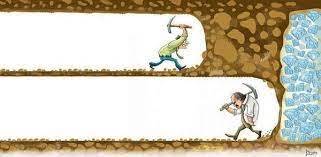
We all will have our ups and downs, but what I’m hoping to show with this episode, is that our results will happen predictably, by taking certain actions, day in and day out, with our desired outcomes in our mind, that eventually become on autosuggestion, as we move towards our goals, overcoming the obstacles along the way. This will encourage all of us, that no matter what results we see today, in front of our eyes, that we must never give up, as you might just be giving up 3 feet before gold,[iii] (which is a concept from Chapter 1 of Napoleon Hill’s Think and Grow Rich book) that says “one of the most common causes of failure is the habit of quitting when one is overtaken by temporary defeat.” (Napoleon Hill, Chapter 1, Think and Grow Rich). Which brings to my mind another image of this guy giving up as he was almost about to hit it big, discovering the diamonds underground, when another guy, (right above him in the image) who is determined to keep moving forward.
When you hear “success is nonlinear” what comes to your mind?
Stop and think about this for minute, because there is much more to this concept than meets the eye. When I’m looking at the images that come to my mind (the guy on a bike with the obstacles, or the guy digging for diamonds) these images are missing something important—they are missing the huge quantum leap in results that occur for those who don’t give up. After digging a bit, (pun intended here) I found an article that explained what I was looking for from Thomas Waschenfelder and I’ve put his image in the show notes.
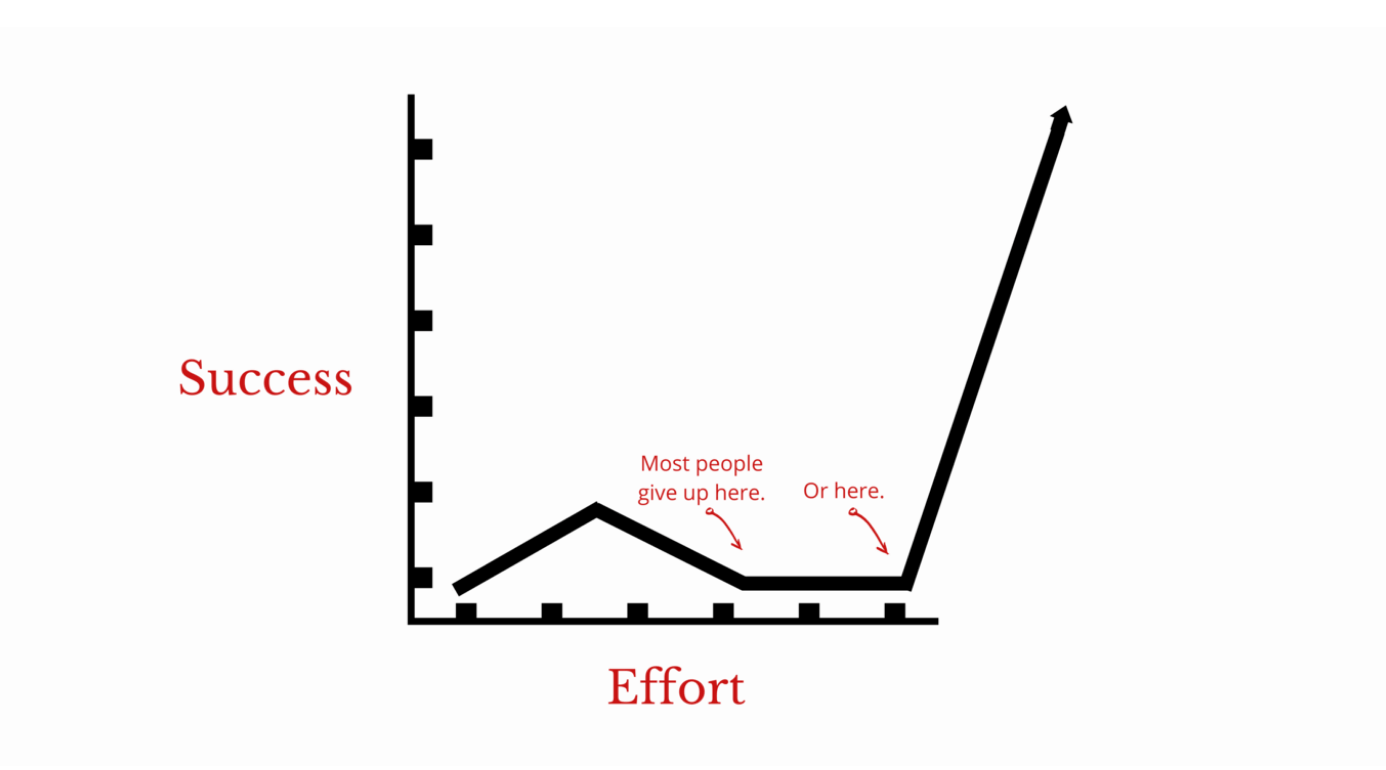
IMAGE CREDIT: Success is Not Linear by Thomas Waschenfelder
Waschenfelder’s diagram “Success is Not Linear” shows two places where people often give up, right before their results were about to shoot up, exponentially.
How Does This Apply to Us at This Point in the Year?
What if we are in Q4 of 2022, and it’s not panning out to be our best year ever? We listened to many different podcasts for new ideas, we took notes, and applied what we could, but life looks pretty much the same in October as it did in January. Most of us would be tempted to give up as we can’t see the quantum leap (your end result) when you’re looking forward. It will only be evident once we hit our goal, and it will be at that point that you’ll be able to explain it to others.
If you’ve attained your goals this year, that’s awesome! You held your vision to the end, and now you can now share your strategy with others. But what if you haven’t? I’m working on something over here, and I haven’t achieved it yet, either, despite all the effort. And there were two specific times (just like in Waschenfelder’s diagram) where things didn’t go my way, where most people would throw in the towel. But when you look at “how success isn’t linear” you can expect the obstacles to appear, and keep going, if you believe in the process.
Do You Believe in the Process?
I can say honestly that I wouldn’t be spending the time to sit at my desk, thinking of how else we could all move the needle forward (myself included), and study the most successful people I know, looking for how science can help us to understand our lives a bit better, if I didn’t believe in this process myself. If you look at Thomas Waschenfelder’s image that describes how most of us think that the more effort we put in (we listen to podcasts, gather ideas, but them into action) so success should follow. But this isn’t exactly how it works. Waschenfelder describes the process reminding us that “the amount of work you put in does not correlate to the success you enjoy at any given moment.” Most people will give up when they don’t see the immediate rewards, and this made me think back to the book You2 by Price Pritchett that I covered on EPISODE #109, February 2021[iv] that was a high velocity formula for multiplying our personal effectiveness in quantum leaps. If you look at Waschenfelder’s image, you can see two places where most people give up. But look at what happens if they kept going! He says it himself. “With one additional move, they see a giant, disproportionally huge impact.” If this is you, doing the work, and not yet seeing the results, go back and listen to EP 109 on the principles of YOU2 that will guarantee you “an explosive jump in your personal performance that puts you far beyond the next logical step.” (Price Pritchett, Page 5, You2). Then when you think that “success is not linear” you’ll have a new image formed in your mind, with all the obstacles along with the way, and the goal, right next to that exponential, quantum leap at the end.
And Now What? (you ask).
This brings us to this week’s Brain Fact Friday and how the Japanese term Kaizen, can help us.
DID YOU KNOW that “the Japanese term Kaizen, or the practice of using small steps for continuous improvement “actually originated with the U.S Military?” (Friederike Fabritius, points this out in her book, The Leading Brain: Work Smarter, Better, Happier) that we covered when we interviewed her way back on EPISODE #27[v] one of our early episodes. I’m thrilled to share that she will be joining us again soon with her new book coming out October 11th (next week) called The Brain Friendly Workplace[vi] but until then, I wanted to tie this powerful concept of Kaizen, that’s used by the U.S. Military (so we know it must be good) with our brain, so we can all benefit from this concept, for the remainder of 2022, and see if it can help us to make a “Quantum Leap or Explosive Jump in our personal or professional performance, that puts us far beyond the next logical step.” (Pritchett)
Friederike, in her book, The Leading Brain says that “procrastination is the principle impediment to initiating any habit change. Large goals can seem intimidating unless broken down into manageable steps. Kaizen, the practice of using small steps, can help you to avoid the threat response (in our brain) that frequently drives procrastination.”
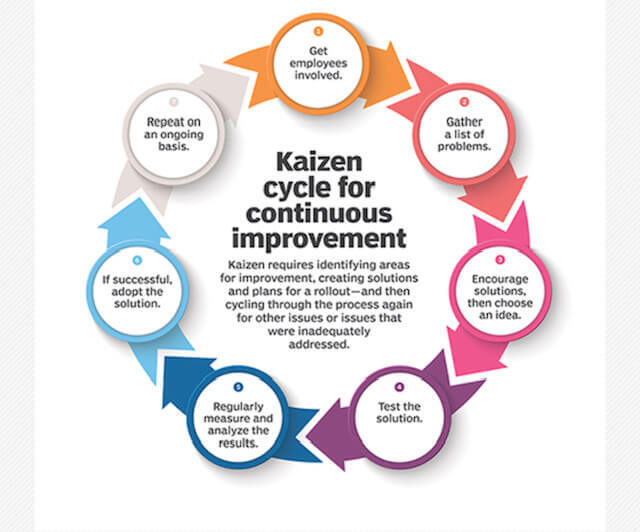
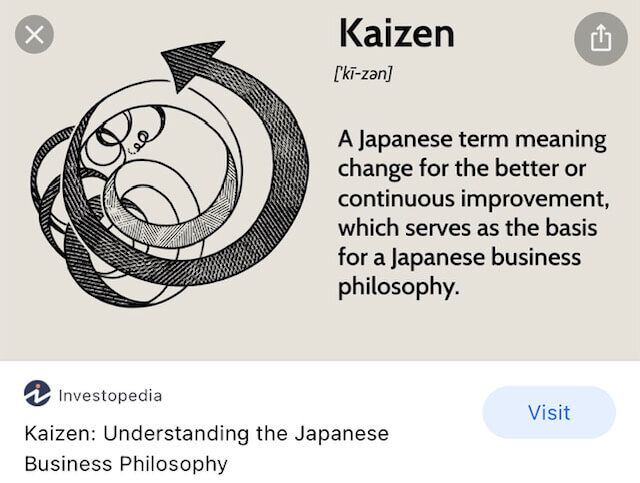
When I saw the concept of Kaizen, I thought we could easily apply it to our health and wellbeing, (in addition to our professional lives). Or any place where there’s too much for our brain to handle, so we don’t do anything at all. This strategy can be used in any field to take our results to the next level.
I saw Dr. Mark Eley[vii] point out that the Kaizen cycle could be used in education with PLC, as the steps can help educators “to achieve better results for the students they serve.” (DuFour, DuFour & Eaker, 2002).[viii]
Whatever sector you are working in, (education, sports, health and wellness) I hope you can see how the Kaizen approach is one way of finding solutions, and breaking through to new levels of achievement, creating your quantum leap.
How Can You Use the Kaizen Strategy in the Workplace?
STEP 1: Get Your Team Together
STEP 2: Write Out Your List of Problems
STEP 3: Brainstorm Solutions, Then Choose Yours.
STEP 4: Test the Solution
STEP 5: Regularly Measure and Analyze the Results
STEP 6: If Successful, Adopt the Solution
STEP 7: Repeat the Process
Keep in mind Thomas Waschenfelder’s image as you are working through the 7 steps to break through to new levels of achievement in your workplace, as there will be times throughout that members of the team will want to give up, if they can’t see the end results a quantum leap that’s miles ahead of where they are now.
How Can You Use the Kaizen Strategy for Improved Health?
For our health, it looks a lot like what I’m doing when I’m testing products and sharing them with you here on the podcast. When our podcast took a turn towards health and wellness during the pandemic, we began to focus narrowly on the TOP 5 health staples[ix] (exercise, sleep, healthy diet, optimizing our microbiome, and intermittent fasting). Narrowing in on these health staples makes it easier to pinpoint where our challenges are.
While recently reading Dr. Tom O’Bryan’s book, You Can Fix Your Brain: Just 1 Hour a Week to the Best Memory, Productivity, and Sleep You’ve Ever Had[x] he mentioned how intimidating it can be to improve our health, with all the different theories, diets, and advice, that often contradicts each other and it’s not uncommon to “find ourselves immobilized with minimal results, or not getting better at all.” (O’Bryan, You Can Fix Your Brain).
Dr. O’Bryan talks about dedicating just one hour a week to make significant changes with our health, and I wondered how he could guarantee change in this way. In the first few pages of the book he offered a tip that I’ll never forget, that will change my brain health forever. He offers this brain health tip in the first few pages of his book called “A Note from the Author: Progress, Not Perfection” that reminds us that significant gains can occur when we do things the “Kaizen” way.
This is just one brain health tip he shares, but I’ll never forget it. He says--
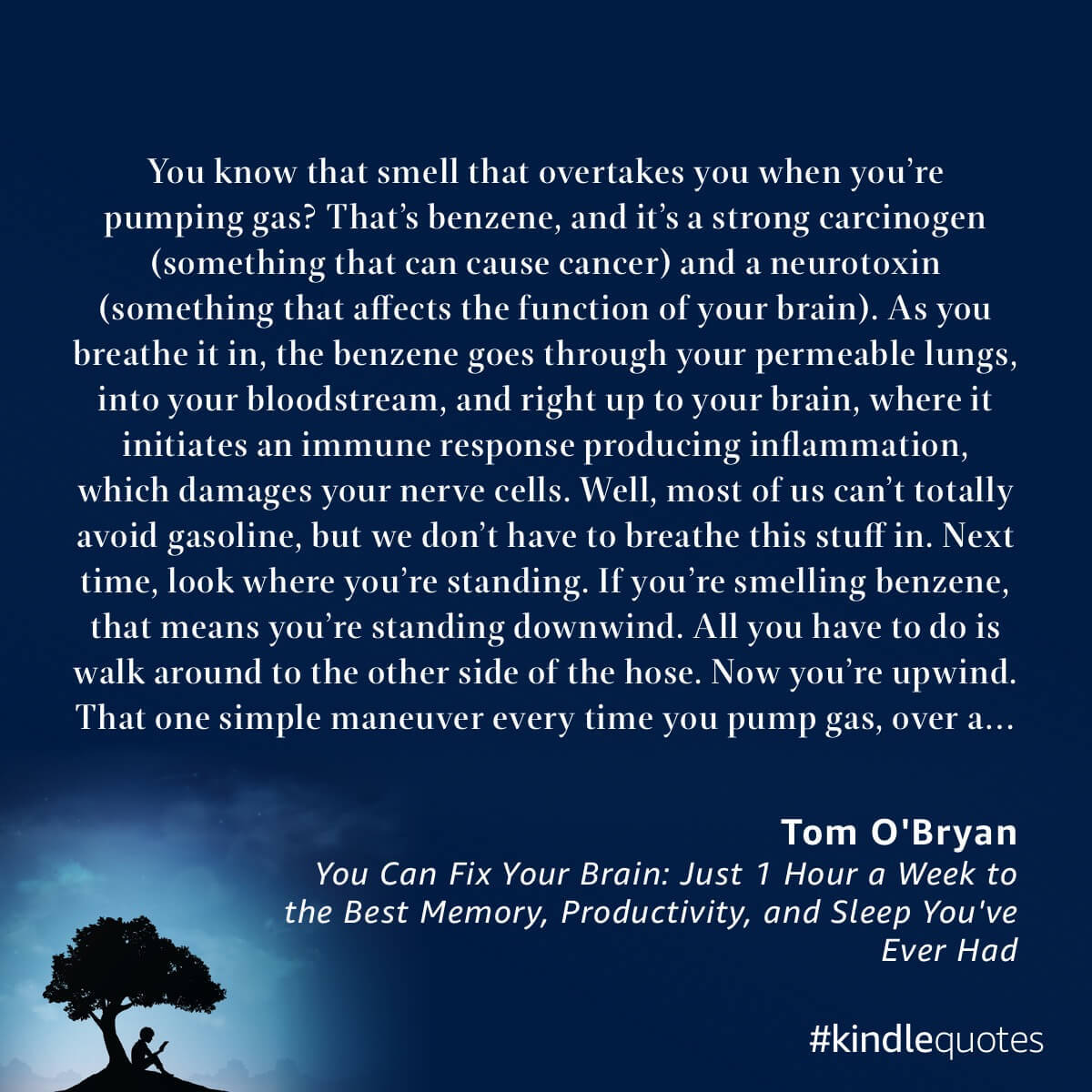
This one simple maneuver every time you pump gas, over a lifetime, dramatically reduces the amount of benzene we are exposed to. The Kaizen way. Small actions add up over our lifetime.
So to conclude this episode and review this week’s Brain Fact Friday,
DID YOU KNOW that “the Japanese term Kaizen, or the practice of using small steps for continuous improvement “actually originated with the U.S Military?” and that “the secret for kaizen is that it operates below the radar of your brain’s threat response and that the actions you are taking are so small, so incremental, and seemingly inconsequential that psychologist Robert Maurer, (says they really) Can Change Your Life: The Kaizen Way” (Friederike Fabritius).
Whether we are using the Kaizen way for our professional or personal lives, we can take small steps towards progress, every day, that one day, will yield our Quantum Leap that puts us far beyond the next logical step.
When you hit your Quantum Leap, I’d love to hear about it.
Until then, I’m still working on mine! I’ll see you next week.
RESOURCES:
Think and Grow Rich Book Study with Andrea Samadi
Neuroscience Meets Social and Emotional Learning Podcast EPISODE 190 PART 1 “Making 2022 Your Best Year Ever” https://andreasamadi.podbean.com/e/think-and-grow-rich-book-review-part-1-how-to-make-2022-your-best-year-ever/
Neuroscience Meets Social and Emotional Learning Podcast EPISODE #191 PART 2 on “Thinking Differently and Choosing Faith Over Fear” https://andreasamadi.podbean.com/e/think-and-grow-rich-book-review-part-2-how-to-make-2022-your-best-year-ever-by-thinking-differently-and-choosing-faith-over-fear/
Neuroscience Meets Social and Emotional Learning Podcast EPISODE #193 PART 3 on “Putting Our Goals on Autopilot with Autosuggestion and Our Imagination” https://andreasamadi.podbean.com/e/think-and-grow-rich-book-review-part-3-using-autosuggestion-and-your-imagination-to-put-your-goals-on-autopilot/
Neuroscience Meets Social and Emotional Learning Podcast EPISODE #195 PART 4 on “Perfecting the Skills of Organized Planning, Decision-Making, and Persistence” https://andreasamadi.podbean.com/e/think-and-grow-rich-book-review-part-4-on-perfecting-the-skills-of-organized-planning-decision-making-and-persistence/
Neuroscience Meets Social and Emotional Learning Podcast EPISODE #195 PART 5 on “The Power of the Mastermind, Taking the Mystery Out of Sex Transmutation, and Linking ALL Parts of Our Mind” https://andreasamadi.podbean.com/e/think-and-grow-rich-book-review-part-5-on-the-power-of-the-mastermind-taking-the-mystery-out-of-sex-transmutation-and-linking-all-parts-of-our-mind/
Neuroscience Meets Social and Emotional Learning Podcast EPISODE #196 PART 6 “The Neuroscience Behind the 15 Success Principles of Napoleon Hill’s Classic Book, Think and Grow Rich” https://andreasamadi.podbean.com/e/the-neuroscience-behind-the-15-success-principles-of-napoleon-hill-s-classic-boo-think-and-grow-rich/
FOLLOW ANDREA SAMADI:
YouTube Channel: https://www.youtube.com/c/AndreaSamadi
Website https://www.achieveit360.com/
LinkedIn: https://www.linkedin.com/in/samadi/
Facebook: https://www.facebook.com/Achieveit360com
Neuroscience Meets SEL Facebook Group https://www.facebook.com/groups/2975814899101697
Twitter: https://twitter.com/andreasamadi
Instagram: https://www.instagram.com/andreasamadi/
REFERENCES:
[i] Neuroscience Meets Social and Emotional Learning Podcast EPISODE #196 “The Neuroscience Behind the 15 Success Principles of Napoleon Hill’s Classic Book, Think and Grow Rich” https://andreasamadi.podbean.com/e/the-neuroscience-behind-the-15-success-principles-of-napoleon-hill-s-classic-boo-think-and-grow-rich/
[ii] Success is Nonlinear: Why Most People Give Up Before the Rewards Published June 5, 2020 by Thomas Waschenfelder https://www.wealest.com/articles/success-is-nonlinear?format=amp
[iii] Napoleon Hill’s 3 Feet from Gold https://www.selfhelpdaily.com/napoleon-hills-three-feet-from-gold/
[iv] Neuroscience Meets Social and Emotional Learning Podcast EPISODE #109 on “Achieving Quantum Level Results Using Pritchett’s You2 Principles” https://andreasamadi.podbean.com/e/achieving-quantum-leap-results-using-price-pritchetts-you-squared-principles/
[v]Neuroscience Meets Social and Emotional Learning Podcast EPISODE #27 with Pioneer in the Field of Neuroleadership, Friederike Fabritius on “The Recipe for Achieving Peak Performance” https://andreasamadi.podbean.com/e/pioneer-in-the-field-of-neuroleadership-friederike-fabritius-on-the-recipe-for-achieving-peak-performance/
[vi] The Brain Friendly Workplace by Friederike Fabritius published Oct. 11, 2022 https://www.amazon.com/Brain-Friendly-Workplace-Talented-People-Quit-ebook/dp/B0B627QGWB/ref=tmm_kin_swatch_0?_encoding=UTF8&qid=&sr=
[vii] Dr. Mark Eley https://twitter.com/1atatym
[viii] What is a PLC by Martin Yan Sept. 25, 2020 https://www.illuminateed.com/blog/2020/09/what-is-a-plc/#:~:text=The%20term%20%E2%80%9CPLC%E2%80%9D%20stands%20for,DuFour%20%26%20Eaker%2C%202002).
[ix]Neuroscience Meets Social and Emotional Learning Podcast EPISODE#87 Top 5 Brain Health and Alzheimer’s Prevention Strategies https://andreasamadi.podbean.com/e/bonus-episode-a-deep-dive-into-the-top-5-health-staples-and-review-of-seasons-1-4/
[x]Dr. Tom O’Bryan You Can Fix Your Brain: Just 1 Hour a Week to the Best Memory, Productivity, and Sleep You’ve Ever Had https://www.amazon.com/You-Can-Fix-Your-Brain-audiobook/dp/B07GTBMFMH
No comments yet. Be the first to say something!